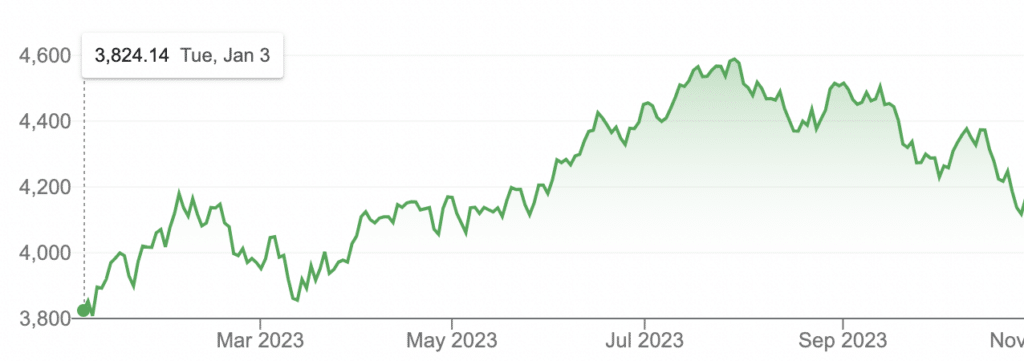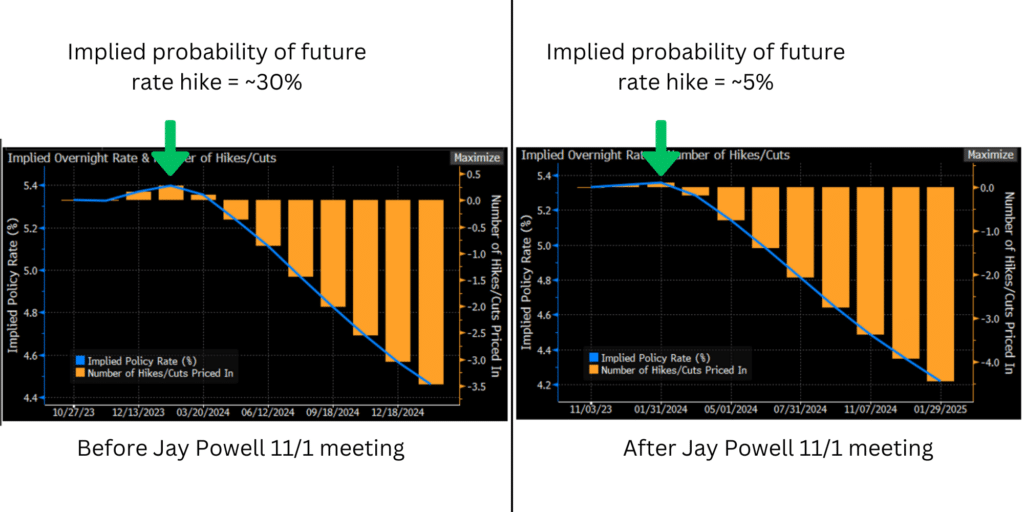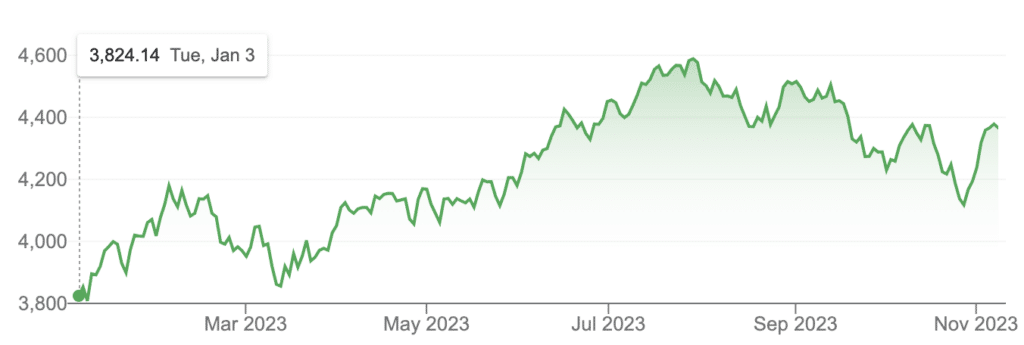Last week provided a terrific, real-life stock market lesson. Let’s dive in.
First, Some Context…
Let’s zoom out to 2023 as a whole.
- The market was up 9% in January
- Then down 8% the next 6 weeks
- Then steadily up from mid-March through the end of July – up 20% on the year
- Leading into a recent 3 months of pain – down 10.3% from July 31 through October 27

Why has the market dropped over the past 3 months? It’s strange logic, but it makes sense if we tease it out.
- We all know inflation reared its head in 2022, causing the Federal Reserve to raise interest rates faster than ever. Higher rates = slower economy = less inflation.
- But a slower economy also presents a challenge for businesses. They’ll be less profitable. And that leads to lower returns for stockholders (stocks, after all, are nothing more than ownership shares of a business).
- Stock investors are peering into the future. Will the Federal Reserve continue to hike rates? That’s bad for businesses, bad for stocks, and would push the stock market down. Or will the Federal Reserve stop hiking or even cut rates? Good for business, good for stocks, markets would rise.
- Paradoxically, good economic news in 2023 has caused investors to think, “The economy is still too hot, so the Fed will have to raise rates in response, pushing the stock market further down.” Good economic news –> lousy stock market news.
That logic explains the market’s pessimism since July.
Changing Expectations
But last week, on November 1st, Jay Powell (Chairman of the Federal Reserve) announced that – at least for now – the Fed was done raising rates. This caught some investors by surprise. To see this surprise in data, let’s look at the Fed Funds futures data a.k.a. how investors believe interest rates will change over time.
Before the announcement (left, below), investors thought there was a ~30% chance of a rate hike by early 2024. After Powell’s announcement (right, below), that probability dropped to 5%. In other words, a previous expectation was significantly changed.

This is a crucial market fact. News alone doesn’t shock the stock market. But news that differs from expectations does. Investors re-write their previous assumptions, changing their opinions about the “correct” price of stocks. And those changes hit the market suddenly.
Powell’s announcement last week did just that.
The end of interest rate hikes means businesses will be more profitable and sooner. That’s good for stock owners. Their shares are worth more than previously assumed. The market jumped up 6% in one week.

The Real Lesson
What have we learned? We want to anticipate when news “differs from expectations,” right? Not quite.
I mean, we would if we could. But we can’t.
Predicting the future is impossible enough. Let alone predicting the future when looking for news that others disagree with.
Instead, the lesson is to accept that you can’t predict the future. And to continue holding your pre-defined asset allocation through thick and thin.
It’s not easy. Watching our stock allocations drop 10% from July through October wasn’t fun! It’s all too human to think, “I’m going to bail. Time to sell. I’ll buy back in once all this volatility is over with.“

Unfortunately, the volatility never ends. It’s a feature of the stock market (not a temporary bug). And volatility acts in both directions. Last week was a perfect example. The stock market can (and will again) jump 6% in a week. You’d have missed that sudden surge if you had sold to wait for calmer waters.
- Stocks will always have days of up or down 1% or more.
- And weeks of up or down 5% or more.
- And months of 10% or more.
- And years of 30% or more.
Not every day, week, or month. But many. If you, like me, plan to hold stocks for decades to come, we’ll face such volatility regularly.
But you won’t hit the peaks if you bail during the valleys. You simply won’t see them coming and won’t be invested when they arrive.

Buy and hold. Stay the course. Don’t try to predict the future.
Thank you for reading! If you enjoyed this article, join 8000+ subscribers who read my 2-minute weekly email, where I send you links to the smartest financial content I find online every week.
-Jesse
Want to learn more about The Best Interest’s back story? Read here.
Looking for a great personal finance book, podcast, or other recommendation? Check out my favorites.
Was this post worth sharing? Click the buttons below to share!